INTRODUCTION – Nose Job (Rhinoplasty)
Because of its location, central on the face, the nose is the predominant facial feature and therefore vital in defining our physical identity. Most patients requesting this procedure have always been concerned about the appearance of their nose. Rhinoplasty is the most challenging cosmetic surgery procedure and demands the highest level of skill, even among experienced plastic surgeons.
Reasons to Consider Surgery
• To correct an inherited trait. Most patients have a nose that is too large or too “pudgy.” They would like it to be more refined.
• To correct an acquired deformity. The nose may be crooked, sometimes because of an old injury.
• To improve the appearance of the nose after a previous operation. Some patients have had previous surgery, but are still concerned about the appearance of their nose and request additional surgery—called a secondary rhinoplasty.
• To correct nasal obstruction. Patients may experience difficulty breathing due to a blocked airway. This blockage is often caused by a deviated septum. There are other structures, on the sides of the nasal passages called turbinates. In allergic individuals, these structures are frequently enlarged and can block the passage of air.
It may surprise people to learn that a rhinoplasty is not like sculpting clay (if it were, the operation would be much easier). On the inside, the nose is a delicate framework of cartilages and bones that make up a structure like the frame of a house. The skin is draped across it like shingles on a roof.
Changes to the outside appearance of the nose are made by adjusting the underlying framework. Experienced surgeons are cautious not to take out too much of this support system, because doing so may cause parts of the nose to collapse, producing a deformity that is difficult to correct.
A Nonoperated Appearance
The ideal rhinoplasty produces a nonoperated, natural appearance. Everyone has seen actors on TV or at the movies who have had “nose jobs” with a result that looks artificial and unattractive.
In most cases, this is due to overtreatment. Undertreatment is always preferable because the nose still looks natural, and it is easier to go back and trim additional tissue than it is to restore tissue to a nose that has been overresected.
The goal today is to produce a natural look. It is far better to have an imperfect natural look than an imperfect artificial look. Most patients understand this and readily agree. Very few people today are looking for a “button nose.” Neither do they wish to have a concave nasal dorsum that looks like a ski jump. The nose should match the face. For example, an overly narrowed nose looks out of place on a wide face. Unlike most other plastic surgical procedures, ethnicity is an important consideration in rhinoplasty. An overly reduced nose in a Hispanic or an African American patient looks odd. We all know some popular examples!
Anesthesia
The surgery is usually done with the patient asleep using IV sedation and a Laryngeal Mask Airway (LMA), similar to other plastic surgical procedures. A certified nurse anesthetist administers the anesthesia. At our facility—a licensed ambulatory surgery center—the procedure is performed without a need for anesthetic gas, intubation, ventilation or paralysis. Patients are asleep, but breathe on their own. This modified general anesthesia enhances patient safety, reduces recovery time, and almost eliminates nausea, which is good news for patients because postoperative nausea is a major source of patient complaints after traditional endotracheal anesthesia. The usual operating time is 1 to 2 hours.
PHOTOS OF FEMALE PATIENTS
A.W. Age 16
Procedure: Rhinoplasty This high school student had her rhinoplasty during the summer.
She was surprised when she returned to school in the fall, many of her friends did not know she had surgery.
The results look natural with no telltale signs of surgery.

A.W. Age 16 Procedure: Rhinoplasty This high school student had her rhinoplasty during the summer. She was surprised when she returned to school in the fall, many of her friends did not know she had surgery. The results look natural with no telltale signs of surgery.
B.O., Age 27
Procedure: Rhinoplasty and Juvederm injection of lips
3 months
Refining the Nasal Tip
R.H., Age 18
Procedure: Rhinoplasty
Before, 5 months after
B.B., Age 18
Breathing Difficulties
Procedure: Septorhinoplasty.

Before, 3 weeks after
D.V.
Age 21
Rhinoplasty
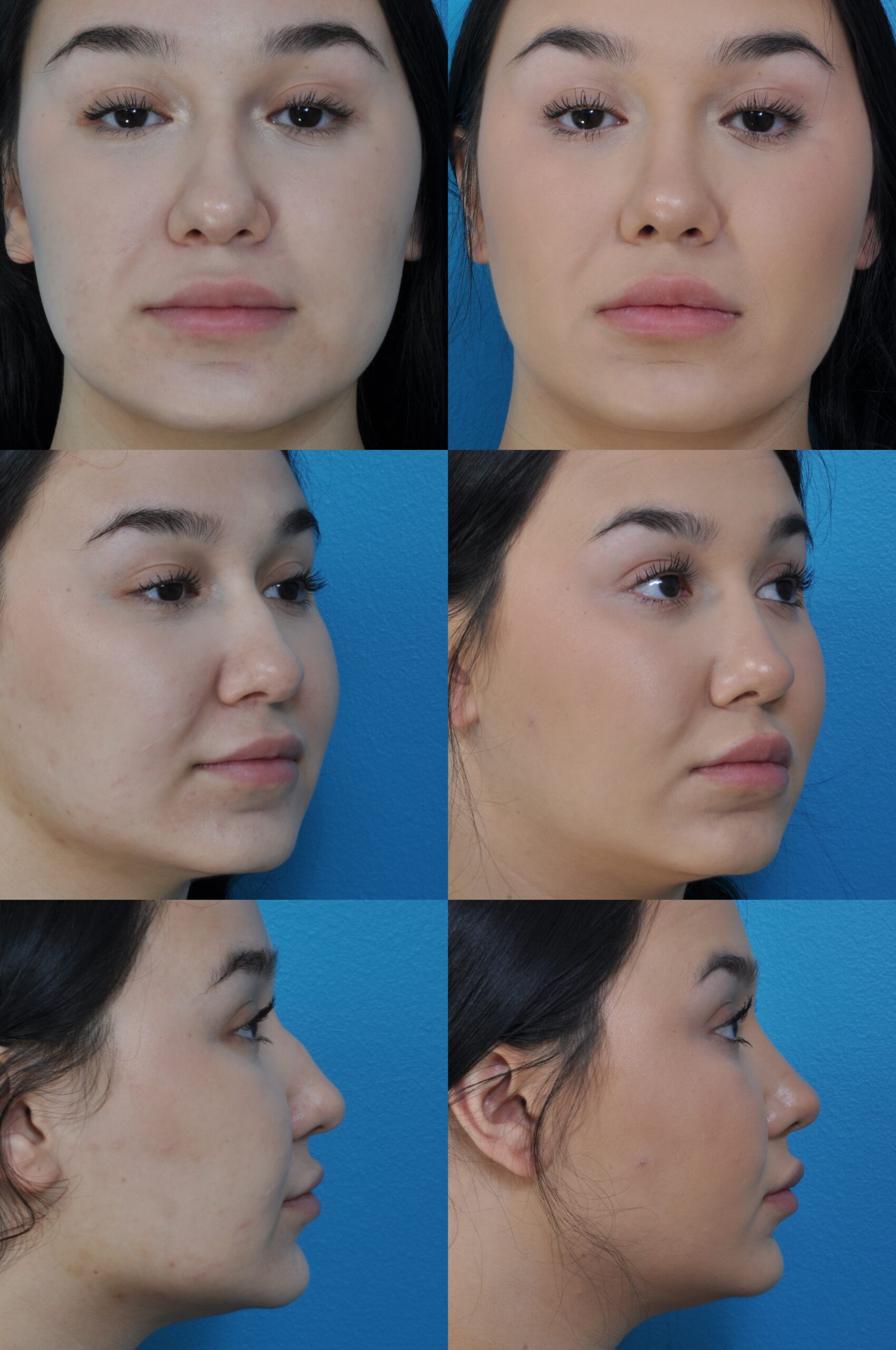
3 months
L.W., Age 23
Procedure: Rhinoplasty, chin augmentation, and submental lipectomy.

Before, 2 months after
G.L., Age 23
Procedure: Rhinoplasty

Before, 2½ months after
Improved Profile
A.P., Age 27
Procedure: Rhinoplasty, bilateral lower transconjunctival blepharoplasties, scar revision of left cheek.

Before, 3 months after
B.K., Age 27
Procedure: Rhinoplasty

Before, 3 months after
N.G., Age 28
Procedure: rhinoplasty and nostril reduction
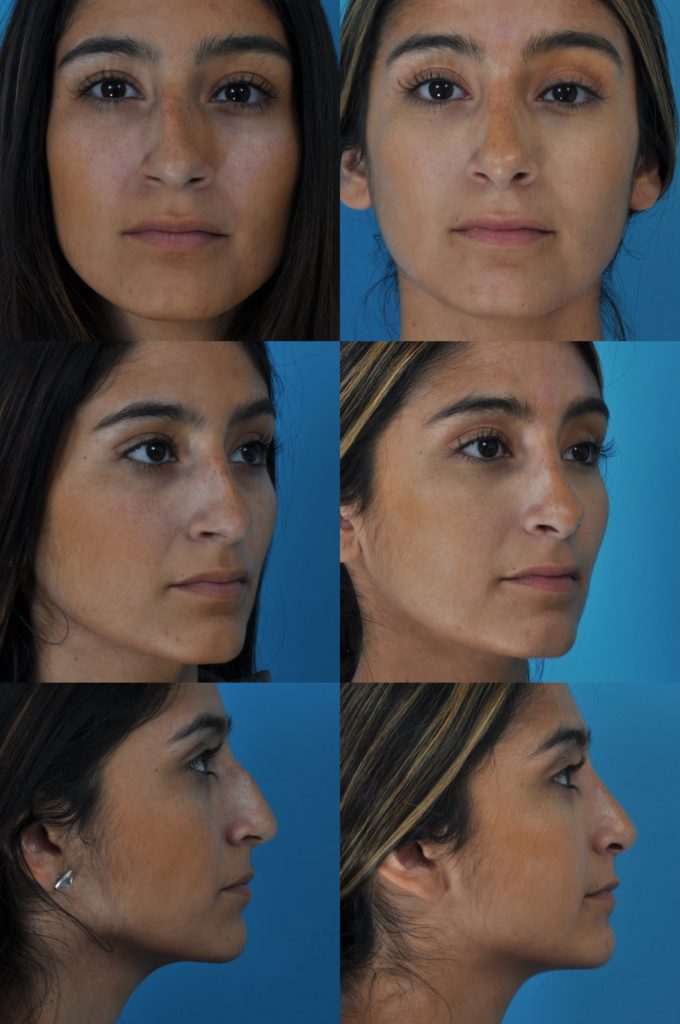
Before, 3 months after
Turbinate Resection
D.W., Age 31
Procedure: Septorhinoplasty and resection of turbinates.

Before, 3 months after

Before, 3 months after
F.P., Age 31
Procedure: Rhinoplasty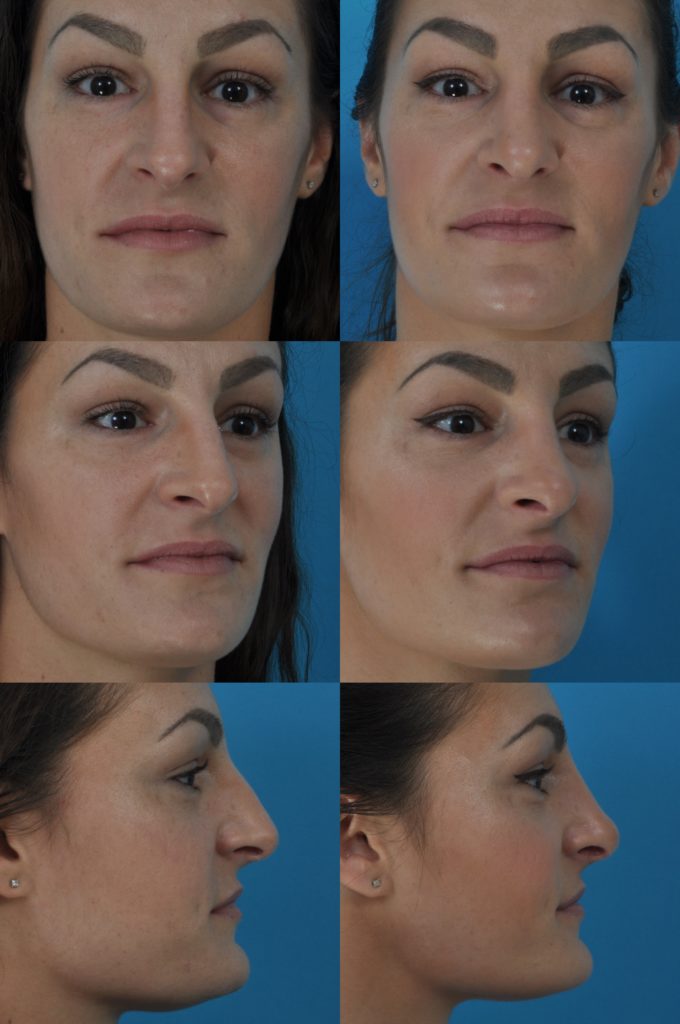
Before, 1 month after
K.H., Age 32
Procedure: Rhinoplasty
Before, 3 months after
S.K., Age 33
Procedure: Rhinoplasty and excision of skin lesion of nasal tip.

Before, 5 years after
S.H., Age 34
Bulbous Nasal Tip
Procedure: Tip Rhinoplasty.

Before, 7 months after
E.H., Age 37
Procedure: Rhinoplasty

Before, 8 months after
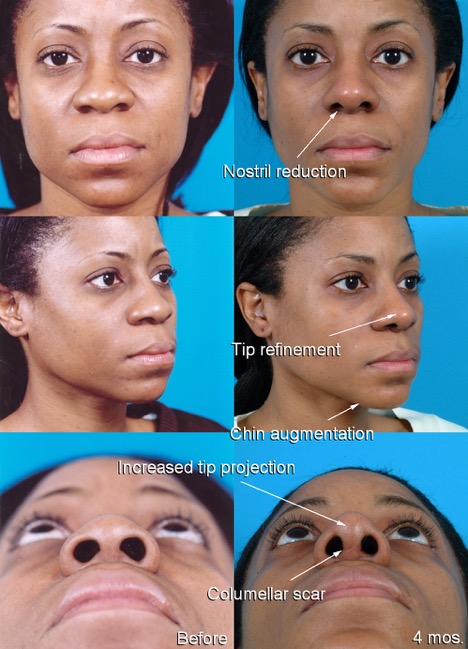
Before, 4 months after
A.M., Age 46
Procedure: Rhinoplasty

Before, 10 months after
Secondary Rhinoplasty
L.B., Age 62.
Procedure: This woman had two previous rhinoplasties as a younger woman. She was self-conscious about her drooping nasal tip and persistent hump. These problems were corrected using a cartilage graft from her left ear.
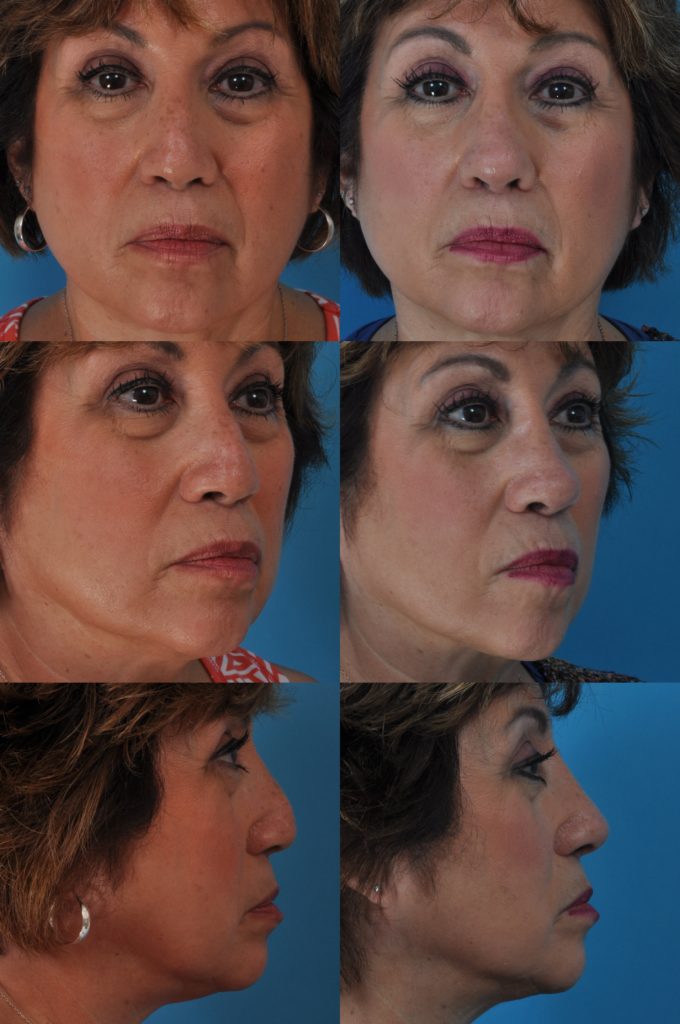
Before, 3 months after
PHOTOS OF MALE PATIENTS
Deviated Septum
R.N., Age 20
Procedure: Septorhinoplasty, excision of old chickenpox scar of left temple, and excision of multiple facial skin lesions.
Before, 2 months after
C.K., Age 23
Procedure: Rhinoplasty and excision of nasal skin lesion.
Before, 3 months after
J.S., Age 24
Procedure: Rhinoplasty and excision of facial skin lesions.
Before, 1 month after
Improved Nasal Contour
A.B., Age 33
Procedure: Rhinoplasty and excision of skin lesion from left side of nose.
Before, 2 months after
M.A., Age 33
Procedure: Rhinoplasty with cartilage graft from left ear.
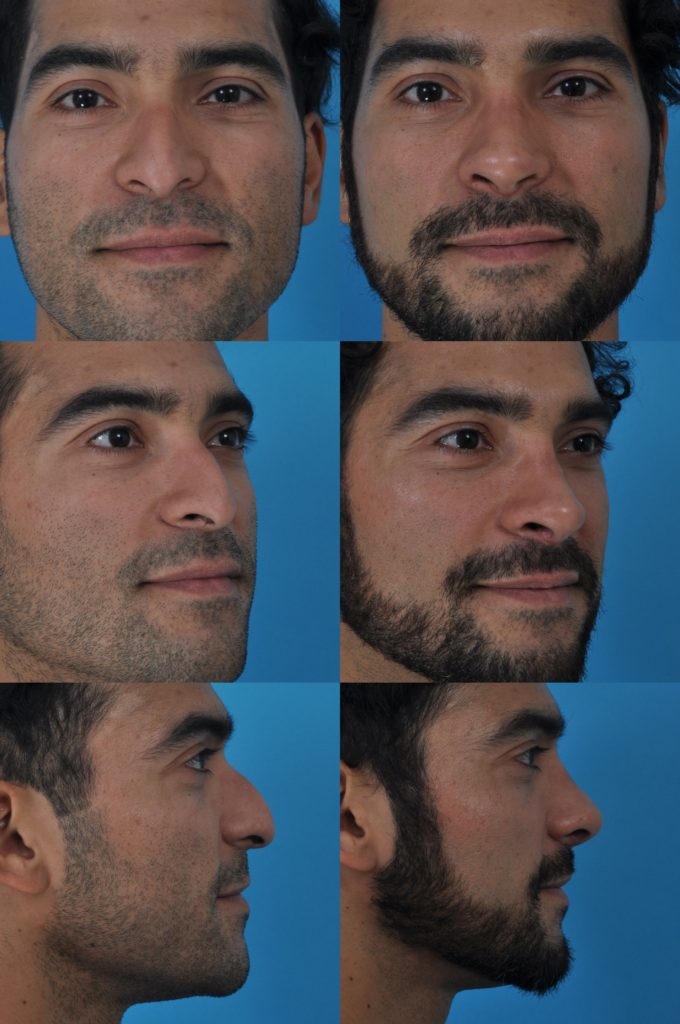
Before, 1 month after
M.T., Age 34
Procedure: Rhinoplasty, submental lipectomy, erbium laser treatment of brown spot of right lateral face, and revision of old scar of left jawline.
Before, 11 weeks after
A.M. Age 37, Engineer
Procedure: Rhinoplasty
Before, 6 months after
Defined Profile
J.L., Age 52
Procedure: Chin/jowl Augmentation, laser treatment of facial veins, facial scar revisions, submental lipectomy, fat injection. Additional procedures, two years later: Facelift, CO2 laser resurfacing, tip rhinoplasty, additional scar revisions and fat injection, upper and lower blepharoplasties, endoscopic forehead lift, and buccal fat pad resection.
Before, 5 years after
90 Degree Nasolabial Angle
R.K., Age 59
Procedure: Rhinoplasty, excision of excess right cheek fat, cautery of nasal veins.
Before, 1 month after
Rhinoplasty: Treatment Areas
The Dorsum
The dorsum of the nose makes up the (mainly bony) portion of the nose where eyeglasses rest. Patients may be concerned about a “dorsal hump,” asymmetry, or excessive width of this structure. Sometimes the dorsum is deficient and needs to be built up.
The dorsum is approached using an incision on the inside of the nose, where it is hidden. A rasp is used to file down excess bone. The rasp is like a nail file, but coarser. The profile of the nose is checked frequently as it is reduced. Rasping continues until a pleasing profile is obtained.
After reducing the profile of the nose, the dorsum needs to be narrowed to avoid the appearance of a flat-top. The nasal bones are folded in to produce the desired narrowing. A mallet and curved chisel are used to release the nasal bones where they are attached to the cheek bones, allowing it to be folded in. This is done on both sides, using small incisions that are hidden inside the nose.
These procedures make up the bony work, which is needed in patients with a deformity of the bony part of the nose. This surgery causes most of the swelling and bruising under the eyes that appear after surgery.
Is It Necessary to Break the Nasal Bones?
Many people have seen a rhinoplasty on TV or on the internet. Most find the part showing the surgeon breaking the nasal bones particularly unappealing. They may have heard that a rhinoplasty is painful and ask if there might be a way to avoid breaking the nasal bones. However, in most cases, it is simply not possible to reduce the size of the nose or reduce the hump without including this part of the procedure. The profile would good after removal of the hump, but on the frontal view the nose would appear too wide (an “open book deformity”). Of course, patients are asleep during surgery, and the recovery is not as painful as people imagine it to be. There is bruising and swelling but minimal discomfort. Patients tend to look worse than they feel.
The Tip
The tip is the soft part of the nose. Patients having bony work on the dorsum typically also have work on the tip to refine the cartilages and reduce the tip, so it is properly balanced with the reduced dorsum.
Occasionally, a patient with a large, projecting, or “bulbous” tip, but a relatively small dorsum, may require a tip rhinoplasty alone. In this case, the cartilages are trimmed, but the nasal bones are not broken.
The tip is made of a delicate framework of cartilages. Working through incisions just inside the nostrils, the “alar” cartilages are exposed. These cartilages can be trimmed to refine the appearance of the tip. Sometimes the alar cartilages are shortened to make the nose less prominent. They are often brought together in the middle with sutures, making the tip of the nose appear less boxy or bulbous. The incisions inside the nose are all closed with absorbable sutures, which dissolve in a few weeks.
After a tip rhinoplasty, there is swelling of the tip of the nose, but very little swelling and bruising of the face. There is virtually no discomfort after a tip rhinoplasty and minimal downtime.
Treating Wide Nostrils
Patients with wide nostrils may request narrowing of the nostrils to reduce “alar flaring,” which may be accentuated by smiling. Incisions are placed in the crease around the base of each nostril. A portion of the floor of each nostril is removed, and the bases are advanced inward, reducing the circumference of the nostrils (See Illustration). The small sutures are removed about 1 week after surgery. This maneuver is often included in non-Caucasian rhinoplasties.
Open vs. Closed Approach
In a closed rhinoplasty, the incisions are all hidden inside the nose. The open approach makes use of an external incision across the “columella” (the vertical structure separating the nostrils). The skin of the nose is peeled back to expose the cartilage framework. This incision usually heals well and is inconspicuous.
There is a debate among plastic surgeons as to which is superior, the open or closed approach. Some surgeons do virtually all of their rhinoplasties using an open approach because it provides optimal exposure of the tip cartilages. However, the open technique does necessitate an external scar and more dissection.
Some surgeons prefer the closed approach for the majority of their patients. It often depends on their training and comfort level. My preference is to use the closed approach for primary (no previous surgery) rhinoplasties, and the open approach for more difficult secondary (previous surgery) cases where there is scar tissue that makes the dissection planes more difficult. If I can avoid the additional dissection and columellar scar of the open approach without sacrificing results, so much the better. However, the approach is of secondary importance to what is done to the underlying structure of the nose. If additional exposure is necessary to do the job properly, I do not hesitate to use an open dissection, peeling the skin back off the tip for full exposure. Patients understand that they will have a small scar across the columella.
The Skin
People wonder how cosmetic nose surgery can be done without trimming any skin. You’d think there would be excess skin after the nasal structure is reduced. Of course, any external incisions to remove extra skin would leave unacceptable scars. Fortunately, the skin is able to contract after it is redraped on the reduced nasal framework. Because of its inherent elasticity, it can take up the slack. This “shrink-wrap” property of living tissue is a small miracle in itself, avoiding the need for unsightly scars on the nose, and in fact making this surgery feasible.
Thick Skin and Rhinoplasty
Some patients have thick skin with deep pores. This type of skin is called sebaceous. A rhinoplasty does not change the quality or thickness of the skin. Thick skin can be a limiting factor in patients who desire a refined tip. There is a limit to how much the skin can be thinned.. Overthinning the skin may interfere with blood supply and cause skin loss with scarring. Efforts to compensate for this skin limitation by overresecting the cartilage framework risk collapse. When I discuss this practical limitation with patients, Michael Jackson’s name often comes up as an example of overtreatment with disastrous results (Everyone agrees he should have stopped circa 1983 when he appeared on the “Thriller” album). It is extremely difficult or impossible for any surgeon to treat complications resulting from overresection. The antiquated label “nasal cripple” has been used to describe such a result.
Grafts
Plastic surgeons commonly take grafts of cartilage from the septum or ears to use in the nose when performing a non-Caucasian rhinoplasty, particularly in Asians. These cartilage grafts may be used to build up the dorsum of the nose in patients with a flat nasal bridge or to increase “projection” of the nasal tip. Projection refers to how far the tip of the nose sticks out from the face in a forward direction (the extreme example being Pinocchio). I usually obtain cartilage from the septum and ear(s). The back of the ear is an excellent donor site because the incision is hidden in the crease behind the ear and no one can tell that cartilage has been taken.
Cartilage Grafts vs. Silicone Implants in the Nose
Asian plastic surgeons often use silicone implants in their Asian patients to augment a flat dorsum. These L-shaped implants do not absorb over time, and the operation is fast and relatively easy, because the graft material is off-the-shelf and there is no need for additional dissection to harvest graft material. The downside is that silicone implants are encapsulated by the body and remain foreign objects, subject to movement, infection, and possibly extrusion (sticking through the skin) in rare instances.
By contrast, most North American surgeons prefer to use patient’s own tissue whenever possible, having been taught during residency to replace missing tissue with tissue that has similar characteristics. Living tissue heals to the surrounding tissue, is natural in consistency and is unlikely to become infected later or extrude. But the surgery takes longer and requires a high level of surgical expertise. Furthermore, living tissue, whether cartilage or bone, can undergo some degree of absorption over time.
Touch-up Rhinoplasty
Some patients return with a persistent or minor deformity that may benefit from a revision. Even experienced plastic surgeons reoperate on about 15% of their rhinoplasty patients. Such patients are hard to predict because of the dynamic nature of healing. It does not necessarily follow that a surgeon who claims fewer touch-up procedures is better—they may simply be less perfectionistic about the result. A touch-up rhinoplasty may be recommended to treat a persistent contour irregularity of the dorsum, or to further refine the tip. Typically, the cost of such a touch-up is discounted to cover the cost of the anesthesia and surgery center.
Pursuing Perfection
Perfection, while the goal, is unattainable. One well-known expert in nose surgery commented that he had never had a “perfect 10” outcome—he could always spot something that could be a little better. Patients need to have appropriate expectations. It may be wiser to accept an improved, although imperfect, result than to pursue perfection, which may ultimately lead to a less satisfactory outcome. Subsequent nose operations are more difficult than the original because of alteration of the tissues and scarring of tissue planes. For the reason, secondary rhinoplasties must be undertaken with caution if at all. Clearly-defined goals are essential. Fortunately, patient satisfaction remains very high if patients are properly counseled and have reasonable expectations.

Patients awaken in the recovery room wearing a splint over the nose with a small gauze dressing taped under the nostrils called a mustache dressing. The back of the bed is elevated to reduce swelling. Depending on the amount of swelling and bruising, which is variable, patients tend to look worse than they feel.
Swelling
At home, pillows or a recliner may be used to provide head elevation. It is important for patients to avoid sneezing or blowing the nose for about 10 days, so there is no undo stress on the nasal cartilages and grafts, if used.
The Nasal Splint
A nasal splint is usually used after surgery on the dorsum and occasionally after surgery on the tip. However, some surgeons have given up using a splint at all. The splint is really an extra precaution to help remind the patient to protect the nose, but it is questionable whether it is really necessary. I still use a splint in most cases, but it is optional. I may choose not to use it if I’m also doing laser resurfacing on the skin. The nasal splint needs to be kept dry or it will come off.
Postoperative Drainage
The nose has an excellent blood supply. There is bound to be some bloody drainage after surgery. Usually there is minimal, if any, oozing after 24 hours.
Nasal Packing
Packing or internal splints are something of a ritual for many surgeons; increasingly, surgeons are starting to do without packing whenever possible. Packing forces the patient to mouth-breathe, and this can be the worst part about recovering from a rhinoplasty. I have personally experienced nasal packing for 4 days after my own septorhinoplasty when I was an intern and will not forget it. This personal experience influenced by practice as a surgeon; on the rare occasion that I use packing, it invariably comes out the morning after surgery.
Healing After Surgery
Patients are usually seen in my office the day after surgery. If nasal packing has been used, which is infrequent, it is removed. Bathing and showering can be resumed the day after surgery, with care to keep the splint dry. The splint stays on for 4 to 5 days before it is removed in the office. If it comes off on its own earlier, that’s fine—it can be left off. Any sutures inside the nose dissolve. If external sutures were used across the columella (the vertical part dividing the nostrils), these sutures are removed about 1 week after surgery.
The nasal tissues heal rapidly. The nasal bones are firmly healed about 10 days after surgery and unlikely to move. Exercise can be resumed at that time. Swelling under the eyes usually goes away within a week. Bruising is variable from patient to patient, and can take longer than a week to go away, but may be camouflaged with makeup. Most patients return to work in 1 week, or 2 weeks for a job requiring heavy physical activity. Occasionally, patients return to work only a few days after surgery, still wearing the nasal splint.
Swelling of the dorsum of the nose gradually goes away over about a month. Tip swelling is notorious for taking a long time to go down, even up to a year. Accordingly, patients will not be able to appreciate the full benefit of the surgery for several months. Of course, patients have lived with their larger noses for years; there is no urgency. They just need to know that healing is a gradual process, so they don’t expect the final result right away. For some patients, this gradual change in appearance may be an advantage in that the change is not too obvious at first to friends and co-workers. Nasal congestion is to be expected after surgery and gradually improves as the swelling goes down inside the nose.
Many patients are worried about how other family members will react. As long as the dreaded over-reduction is avoided, the reaction of others is almost always positive. There is no shame in wanting to look your best, and a good result draws compliments and praise from others. Patients may be surprised that not everyone knows they had surgery, even though the difference is obvious in before-and-after photographs. If the result looks natural, with no obvious scars or other signs of surgery, acquaintances may be none the wiser.
Undercorrection
The most common complication of rhinoplasty is undercorrection of a large nose, or inadequate refinement of the nasal tip. Sometimes there is a persistent irregularity of the dorsum or a profile that remains suboptimal, such as the polly-beak deformity. These problems may be treated by reoperation. Skin thickness limits the degree of refinement possible in patients with thicker skin, and attempts to thin the skin are dangerous. In rhinoplasty, prudence can be a virtue.
Overcorrection
Overcorrection is a more difficult problem to deal with than undercorrection, usually calling for the use of grafts. We have all seen examples of over-resection among celebrities. It is important to avoid this result because it is much more difficult to restore a natural appearance to an overly resected nose than it is to further refine a nose. Rebuilding is much more difficult than trimming down. Additional dissection is needed to obtain grafts. In some cases, so much tissue has been removed from the nose that repair is impossible.
Infection
Because of the excellent blood supply of the nose, infection is unusual. Sometimes an infection can develop in the presence of a silicone implant (which is one reason I don’t use them) and will only clear up after the implant is removed (See photo).
K.T., age 36/38, Salon Owner
Description: Infection and Extrusion of Silicone Implant—Removal of silicone implant followed by staged nasal reconstruction with cartilage grafts taken from both ears.
Comments: This 36-year-old Asian patient complained of pus oozing from her nasal tip. Eight months previously she had a rhinoplasty while visiting Vietnam. The L-shaped silicone implant was visible when I looked inside her right nostril (called extrusion). This was a difficult situation and this patient, who runs a beauty salon, had high expectations. The infection could be cleared only by removing the implant and allowing the tissues to heal, followed by a later procedure to rebuild the nose. I removed the implant, continued antibiotics to clear up the infection, and then performed a staged reconstruction using cartilage grafts from both ears. Despite having to go through staged surgery, this patient came to a successful outcome.

Before, 2 years after
Scarring
Intranasal scars are concealed within the nose. The columellar scar used in the open rhinoplasty usually heals well and is not very conspicuous. When the nostrils are narrowed, there are scars at the nostril bases. These incisions are placed in the natural crease around the base of the nostrils to hide them.
Body Dysmorphic Disorder
Body Dysmorphic Disorder is not really a complication but a psychological disorder. It is an obsession with a physical detail that seems insignificant to others, but starts to consume an inordinate amount of time and attention, to the point that it interferes with patients’ lives. These patients become fixated on the appearance of a body part, in this case the nose, and will not be satisfied regardless of the surgeon’s skills and efforts. Body dysmorphic patients are well-known to plastic surgeons and, unfortunately, difficult or impossible to identify before surgery. Such patients do not understand the limitations of surgery or, perhaps more accurately, have psychological issues that cannot be remedied by surgery. They are not merely disappointed, but rather enraged, and blame the surgeon for their dissatisfaction. Any experienced surgeon has stories about such patients, who leave an indelible impression.
The splint is a semitransparent molded piece of plastic used to help protect the nose after surgery, especially when the nasal bones have been reset. If you had a tip rhinoplasty, you may not require a splint. The splint is removed in the office about 5 days after surgery. If it comes off before that time, just leave it off. Be careful not to inadvertently bump your nose. Be careful around children and elbows.
You may wear contacts, but glasses may cause undue pressure on the nose, and should be avoided (unless taped to the forehead or propped up on your cheeks) for 1 week.
Sneezing or blowing the nose should be avoided for 10 days after surgery. If you need to sneeze, do so with your mouth open. The tissues need to be healed enough to tolerate the high pressures caused by sneezing.
Elevation help reduce swelling and discomfort during the first 24 hours. Use a recliner or prop your upper body up with extra pillows for the first 2 or 3 days after surgery. Elevation is most useful during the first few days after surgery.
You may start bathing and showering the day after surgery. You may also shampoo your hair, but be careful to keep the splint dry. The splint can tolerate a few drops of water but will come off if it gets saturated.
Packing is rarely used in my practice. When Vaseline gauze packing is used, it comes out the day after surgery. Removal of the packing is uncomfortable and can cause tearing, but it is quick and patients feel better immediately after it is removed.
A gauze “mustache dressing” is used under the nose after surgery to collect any oozing from the nose, which occurs normally, especially during the first several hours after surgery. Apply a new gauze dressing when it becomes saturated, using paper tape to hold it in place. When there is no longer any drainage on the dressing, it may be discontinued.
Avoid trying to remove any clots from the inside of the nose, because this may cause bleeding. At the office, the nostrils will be cleaned with hydrogen peroxide to remove any dried blood. If incisions were used around the nostrils (to reduce nostril width) apply a small amount of antibiotic ointment with a Q-tip, but don’t try to clean the inside of the nose. It is better to leave small dried blood clots inside the nose alone rather than to try to take them out too early, before the wounds have fully healed.
Avoid strenuous activity during the first week after surgery. Vigorous exercise increases blood pressure, increases swelling, and may cause bleeding. Exercise can be resumed after 1 week, but it is best to avoid contact sports for at least 2 weeks until the nasal bones are firmly healed.
Patients with office jobs usually return to work 1 week after surgery, despite some degree of swelling and bruising. Makeup may be used to help hide bruising. Patients who work at home, or have positions with minimal public contact, may return to work sooner if they feel up to it, and are no longer taking painkillers. Those with physical jobs should take 2 weeks off. However, if the tip alone is treated without any bony work, there is very little bruising and patients can return to work a few days after surgery. Usually swelling of the nasal tip is not objectionable in the workplace.
Q: How old must I be to have this surgery?
A: Unless you have had an injury or breathing problems, it is best to wait until the bones in your face are no longer growing. This development is complete in girls by age 16 and boys by age 17. But these are not rigid rule however. A child with a nasal deformity related to a cleft palate is often treated in childhood. If a nose is particularly unattractive, it is better to operate earlier, even in the midteens, to spare the grief and ridicule that will predictably occur otherwise. One memorable 14-year-old patient of mine was transformed after her surgery from being socially withdrawn to becoming much more outgoing, confident and popular. There would have been nothing to gain and possibly much to lose by waiting.
Q: Will I have a scar on my nose?
A: It depends on the approach used. There are two approaches. The closed approach uses incisions that are entirely hidden within the nose and do not leave visible scars. The open approach makes use of an external incision across the columella (the vertical column separating the nostrils), leaving a visible scar, but it is usually inconspicuous. When the nostril bases are narrowed (commonly for the non-Caucasian rhinoplasty), small incisions are used around the bases of the nostrils, which leave scars that are typically well-concealed in these natural creases.
Q: Can you make me a nose that looks like someone else?
A: No. It is impossible to replicate the tissue characteristics of another person. Even if that were possible, it would be inadvisable, because one person’s nose would look out of place on another person’s face.
Q: Do you need to break the bones?
A: The answer depends on whether there is excess bony tissue of the dorsum or bony asymmetry that can only be corrected by trimming and adjusting the nasal bones. If there is a hump, or if the dorsum is too wide, it is necessary to remove the hump by rasping (filing) it down and then repositioning the nasal bones. If the tip is to be narrowed, it may be beneficial to also narrow the dorsum to balance the reduced tip. Usually patients don’t like the idea of having their nose broken. They may have seen this maneuver on TV and (understandably) are not smitten with the idea of being on the receiving end of a mallet and chisel! However, most patients with a large nose understand the need for a bony reduction. I reassure them that they will, of course, be asleep during the surgery and usually the postoperative discomfort is not as bad as they imagined. Some patients with large, projecting, or bulbous nasal tips may require a tip rhinoplasty alone. In this case, the cartilages are trimmed, but the nasal bones are left alone.
Q: Is it painful?
A: There is some pain after surgery, but it is usually well-controlled with painkillers. This medication is prescribed before surgery, so that you have it available after surgery. There is very little discomfort if the tip alone is treated. Headaches may be treated with acetaminophen. Usually patients experience less pain that they anticipate.
Q: Will I have any packing in my nose?
A: Usually nasal packing is unnecessary. If I do find it necessary to use packing, I take it out the next morning. Packing is uncomfortable because it forces you to breathe through your mouth, so I avoid it whenever possible.
Q: Can I blow my nose?
A: Do not blow your nose and avoid sneezing for 2 weeks. Remember, nothing is actually holding the nasal bones in position as they heal. There are no little screws holding them in place. The surgeon places them in the desired position and may apply a splint as an extra precaution. We don’t want any undue pressure or movement that might move the nasal bones out of position. Fortunately, these bones heal quickly and, after about 10 days, they are unlikely to move unless you are actually struck in the nose.
Q: When does the splint come off?
A: Usually I take the splint off 5 days after surgery. When I perform a tip rhinoplasty, without any bony work, I may not even use a splint. If the splint comes off before 5 days, don’t worry, just leave it off and be careful not to bump your nose. I use a semitransparent plastic splint. You need to keep it dry, or it will come off.
Q: How awful will I look?
A: Expect to have swelling of the nose and face, and bruising under the eyes (if the dorsum is treated). Patients usually look worse than they feel, possibly explaining why most people think a rhinoplasty is a painful procedure. Patients having tip rhinoplasties (no bony work) have swelling of the tip of the nose, but very little swelling or bruising of the face. Makeup may be used to help hide facial bruises.
Q: How long does it take before the swelling goes down?
A: Swelling of the dorsum goes down quickly, within a month. Swelling of the tip of the nose is notorious for taking a long time to go down. Tip swelling takes months, even a year, to fully subside. However, the tip is likely to be smaller than its original size within a few weeks after surgery, so the fact that it takes some time to see the final result does not usually pose a problem— you just need to know this so you don’t expect the final result right away.
Q: Are there stitches?
A: Yes, there are yellow sutures on the inside of the nose that dissolve on their own. External sutures (a blue color) may be used when the nostrils are narrowed, or for an open rhinoplasty. External sutures are removed about 1 week after surgery.
Q: What happens to the extra skin?
A: The skin is elastic and will gradually contract down to fit the reduced size of the nasal framework. This is a remarkable property of skin, not found in most artificial materials. Patients are impressed that the skin “shrink-wraps” down like this so that extra incisions to remove skin are not required.
Q: How much time off work will I need?
A: Most patients take 1 week off work to allow the swelling to partially subside. Bruising is usually present for a few weeks. Patients with jobs that call for a high level of physical activity need 2 weeks off. Of course, I’ve had patients get back to work much sooner, particularly if they are not too concerned about bruising or swelling, or wearing a splint in public.
Q: Will I be able to wear my glasses right away?
A: No. You can wear contacts, but glasses cannot be worn after surgery for at least 1 week, to allow adequate healing of the nasal bones. In the meantime, you may tape your glasses to your forehead, or adjust them to rest on your cheeks. If you’ve had a tip rhinoplasty, you can wear glasses right away.
Q: Will insurance help pay for my surgery?
A: There may be insurance coverage for surgery to correct a breathing problem or nasal deformity from injury. Of course, insurance does not pay for surgery that is judged to be cosmetic or is not medically necessary.
Q: How long does the surgery take?
A: The surgery takes 1 to 2 hours, sometimes more if it is particularly difficult, such as a secondary rhinoplasty that involves grafting.
